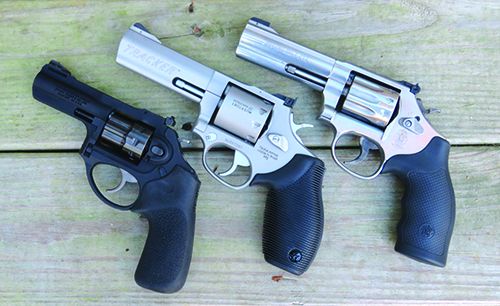
Rimfire revolvers offer a lot of plinking fun. They can also be great training guns to perfect revolver technique without the added cost and recoil of a centerfire revolver. We took a look at three revolvers, all of which have centerfire counterparts. Our test revolvers included an S&W Model 617-6 built on an L-Frame, a Ruger LCRx built on the compact LCR/LCRx frame, and a Taurus 992 Tracker, which is built on Taurus’ medium-size frame. We were mostly looking for accuracy and ease of use. If we could use it as a small-caliber training gun or a trail gun, those would be pluses. What we found in general were accurate revolvers when shooting in single-action (SA) mode, but change to double-action (DA) mode, and we soon realized our trigger finger needed to start weight training. The DA trigger pull weights were very heavy on these revolvers, and that is part of the design. Heavy pull weights ensure the hammer fires rimfire ammo.
How We Tested
We tested at 15 yards with a variety of 22 LR rimfire ammo. With the Taurus we also fired an assortment of 22 WMR ammo. The 22 Long Rifle cartridges consisted of hunting ammo and target ammo velocities that ranged from fast to slow, respectively. Mild PMC Target ammunition is loaded with a 40-grain lead round nose (LRN) bullet. Hot Aguila Interceptors are loaded with a 40-grain round-nose solid (RNS) projectile. The Winchester Power-Point with a 42-grain hollow point (HP) had a velocity just below the Aguila. The 22 WMR cartridges consisted of two loads from CCI, both 40-grain bullets, but one was a solid and the other a hollow point. The third was Federal Game-Shok with a 50-grain jacketed hollow point (JHP).
Revolvers have legendary reliability, and here they went bang every time, even when we stuffed their chambers with all types of ammo. The fact is, rimfire bullets’ dry lubricant, lead shavings from the bullets, and powder residue tends to gunk up a wheelgun’s works, and in some extreme situations can impede the rotation of the cylinder or clog the frame-mounted firing pin. This is why rimfire revolvers are more sensitive to dirt than centerfire revolvers. We love a challenge, so we fired these revolvers until they were dirty and had fun shooting them. Best of all, we did not experience any issues with any of the guns tested. All the prices reflect current amounts from BudsGunShop.com. In the end, we did settle on one we liked the best. Here are the details.
22 LR AND 22 WMR RANGE DATA
To collect accuracy data, we fired five-shot groups from a bench using a rest. Distance: 15 yards with open sights. We recorded velocities using a ProChrono digital chronograph set 15 feet from the muzzle.| Aguila Interceptor 22 Long Rifle 40-gr. RNS | Ruger LCRx | S&W 617-6 | Taurus 922 Tracker |
| Average Velocity | 1042 fps | 1079 fps | 1079 fps |
| Muzzle Energy | 96 ft.-lbs. | 103 ft.-lbs. | 63 ft.-lbs. |
| Smallest Group | 1.49 in. | 0.78 in. | 0.52 in. |
| Average Group | 1.69 in. | 0.83 in. | 0.81 in. |
| PMC Target 22 Long Rifle 40-gr. RNS | Ruger LCRx | S&W 617-6 | Taurus 922 Tracker |
| Average Velocity | 804 fps | 840 fps | 834 fps |
| Muzzle Energy | 57 ft.-lbs. | 63 ft.-lbs. | 62 ft.-lbs. |
| Smallest Group | 0.86 in. | 0.83 in. | 0.40 in. |
| Average Group | 1.34 in. | 0.89 in. | 0.69 in. |
| Winchester Power-Point 22 Long Rifle 42-gr. HP | Ruger LCRx | S&W 617-6 | Taurus 922 Tracker |
| Average Velocity | 1026 fps | 1028 fps | 1079 fps |
| Muzzle Energy | 98 ft.-lbs. | 99 ft.-lbs. | 63 ft.-lbs. |
| Smallest Group | 0.92 in. | 0.78 in. | 0.74 in. |
| Average Group | 1.30 in. | 0.96 in. | 0.94 in. |
| Taurus 922 Tracker | CCI Maxi-Mag 22 Magnum 40-gr. JHP | CCI Maxi-Mag 22 Magnum 40-gr. TMJ | Federal Game Shok 22 Magnum 50-gr. JHP |
| Average Velocity | 1149 fps | 1160 fps | 995 fps |
| Muzzle Energy | 117 ft.-lbs. | 120 ft.-lbs. | 110 ft.-lbs. |
| Smallest Group | 1.18 in. | 0.64 in. | 1.16 in. |
| Average Group | 1.56 in. | 0.73 in. | 1.23 in. |
Smith & Wesson Model 617-6 160584 22 LR, $725
GUN TESTS GRADE: A (OUR PICK)
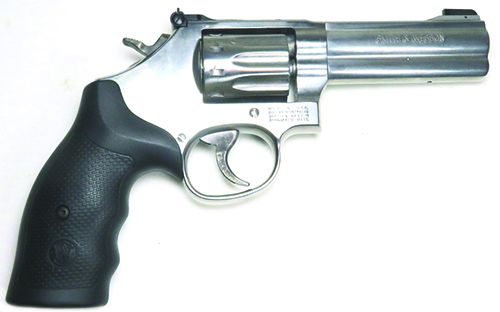
| Action | Revolver, Double Action |
| Overall Length | 9.1 in. |
| Barrel Length | 4.0 in. |
| Sight Radius | 5.3 in. |
| Overall Height | 5.5 in. |
| Maximum Width | 1.4 in. |
| Weight Unloaded | 39.0 oz. |
| Weight Loaded | 45.0 oz. |
| Cylinder Gap | 0.010 in. |
| Capacity | 10 |
| Frame Finish | Stainless Steel |
| Barrel/Cylinder Finish | Stainless Steel |
| Frame Front Strap Height | 2.5 in. |
| Frame Back Strap Height | 3.5 in. |
| Grip | Textured Finger Groove Rubber |
| Grip Thickness (max) | 1.1 in. |
| Grip Circumference (max) | 5.0 in. |
| Front Sight | Ramped and Pinned |
| Rear Sight | Adjustable U-notch |
| Trigger Pull Weight (DA) | 13.0 lbs. |
| Trigger Pull Weight (SA) | 4.9 lbs. |
| Trigger Span (DA) | 3.6 in. |
| Trigger Span (SA) | 3.0 in. |
| Safety | Hammer Block |
| Warranty | None Written |
| Telephone | (800) 331-0852 |
| Website | Smith-Wesson.com |
| Made In | USA |
The Model 617, this in its 6th design iteration, hence the “-6” in the model number, is an expensive rimfire revolver. As we studied and fired it, we found it to be a great choice, especially if you have a centerfire L-frame and want to train with less cost and recoil. This is a serious revolver for the wheelgun aficionado. This would also be a good choice for small-game hunting.
Our sample featured a bright stainless finish typically found on S&W’s other stainless revolvers. We like this finish, and it is easy to clean. The hammer, trigger, and sights are black and contrast nicely. Did we mention this is a beautiful gun? The 4-inch barrel uses a full underlug, so the 617 is a hefty revolver. At 39 ounces unloaded, this is not a lightweight 22 LR handgun.
The cylinder is fluted for all 10 chambers, making it easy to identify it as a rimfire revolver even though it looks a lot like a S&W Model 686. That’s because they use the same frame. The ejector fully dumps 22 LR cases when depressed. We had no issues dumping empties even after extended firing. All the chambers are countersunk. The front lock on the cylinder is located in the end of the ejector rod. A pin in the underlug snaps in place when the cylinder is closed.
The top side of the barrel is bead blasted for a matte, non-glare finish. It also wears decorative grooves on the top side. The front sight is a plain black post pinned in place, which we like. The rear sight is adjustable for windage and elevation, and if you are not familiar with S&W revolver sights, you will need to look at the manual since there is no indication for up/down nor left/right adjustment. The back bottom edge is serrated to kill glare. We would have preferred the entire shooter-facing side of the sight be serrated, not just the bottom portion.
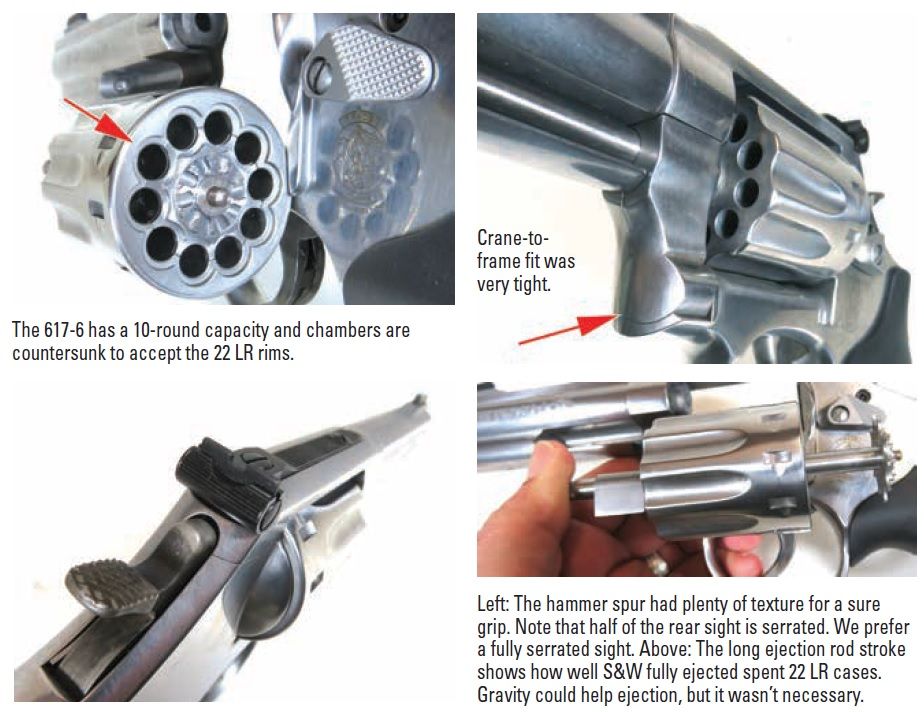
The trigger face is smooth, and that is fine for speed shooting, except the DA trigger pull was 13 pounds. We would have liked it to be less, but it was quite serviceable. SA pull weight was just under 5 pounds, and again, we would have liked it lighter. The DA trigger pull was exceptionally smooth with no stacking. In SA mode there was no creep. This is a really good trigger, even if it is a bit on the heavy side.
The grip is S&W’s newer textured rubber with finger grooves and slight palm swell and flat butt. We like this grip. It fits average and full-size hands equally well.
Going hot, we found the 617-6 offers great accuracy. At 15 yards our best five-shot groups measured 0.78 inches with the hotter Aguila and Winchester Power-Point ammo. The milder PMC Target ammo had a best group of 0.83 inches. On average, the 617-6 shot well under one inch. This is the kind of accuracy needed for humane small-game hunting. Moving to speed shooting in DA mode, our groups opened up, and we attribute this to the heavy trigger. We did encounter a bit of splatter with the S&W, and we did note the cylinder gap measured 0.010 inches. The gap for the Ruger and Taurus measured 0.008 and 0.009, respectively.
Our Team Said: The 617-6 is a hefty, medium-sized revolver with a good trigger in both SA and DA and a large, full-size grip. It was tight and offered good accuracy. This revolver is a must-have if you own a 686 or other L-frame 4-incher. We also think this would make a great small-game hunting revolver. The cost is high, but so is the quality and performance. It’s Our Pick of the three tested here.
Taurus 992 Tracker 2-992049 22 LR/22 WMR, $489
GUN TESTS GRADE: A (BEST BUY)
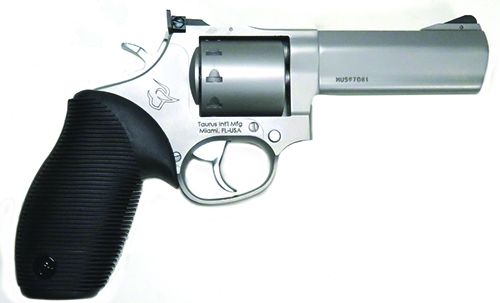
| Action | Revolver, Double Action |
| Overall Length | 8.8 in. |
| Barrel Length | 4.0 in. |
| Sight Radius | 5.6 in. |
| Overall Height | 5.2 in. |
| Maximum Width | 1.5 in. |
| Weight Unloaded | 40.0 oz. |
| Weight Loaded | 45.4 oz. |
| Cylinder Gap | 0.009 in. |
| Capacity | 9 |
| Frame Finish | Matte Stainless |
| Barrel/Cylinder Finish | Matte Stainless |
| Frame Front Strap Height | 2.5 in. |
| Frame Back Strap Height | 3.3 in. |
| Grip | Serrated Rubber |
| Grip Thickness (max) | 1.2 in. |
| Grip Circumference (max) | 5.7 in. |
| Front Sight | Ramp, Pinned |
| Rear Sight | Adjustable U-Notch |
| Trigger Pull Weight (DA) | 15.0 lbs. |
| Trigger Pull Weight (SA) | 6.7 lbs. |
| Trigger Span (DA) | 3.5 in. |
| Trigger Span (SA) | 3.1 in. |
| Safety | Internal Hammer Block |
| Warranty | Unlimited Lifetime |
| Telephone | (305) 624-1115 |
| Website | TaurusUSA.com |
| Made In | Brazil |
The 992 Tracker debuted in 2011 and offers a unique feature for a DA/SA revolver. It has a quick-swap cylinder, allowing the user to fire either 22 LR in one cylinder and 22 WMR in another. While this is a common feature in SAA revolvers, it is novel in a DA/SA revolver. A button, located on the right side of the frame near the top front of trigger guard, allows fast and easy removal of the cylinder assembly. The cylinder-release button engages a groove cut in the axle for the crane. To change cylinder assemblies, push the cylinder latch forward, swing out the cylinder, depress the button, and pull forward on the cylinder. Each cylinder assembly includes the crane and ejector rod. Both cylinders are unfluted, but clearly rollmarked with the caliber. We would have liked the 22 LR cylinder to be fluted and the 22 WMR unfluted, similar to how Ruger differentiates cylinders on its Single-Six convertible SAA revolvers. The front lock on the cylinder is located in the crane. A detent locks into the frame when the cylinder is closed. This was tight with very little wiggle.
Built on Taurus’ medium-size frame and with a full underlug barrel means this is a hefty rimfire revolver. It weighs 40 ounces unloaded. If we had a wish, we would like Taurus to make this revolver with a titanium frame and aluminum barrel sleeve to reduce the weight. The frame and barrel have a matte stainless finish, while the cylinder latch, cylinder button, trigger, and hammer have a chrome finish. It is a smart-looking revolver. The front ramp sight is black and pinned in place, which we like. The ramp has a red insert, which makes it easier for the front sight to stand out and be acquired. The rear sight is fully adjustable and indicates up and right directions. The shooter-facing side of the rear sight is smooth. We would like it better if it were serrated to cut glare.
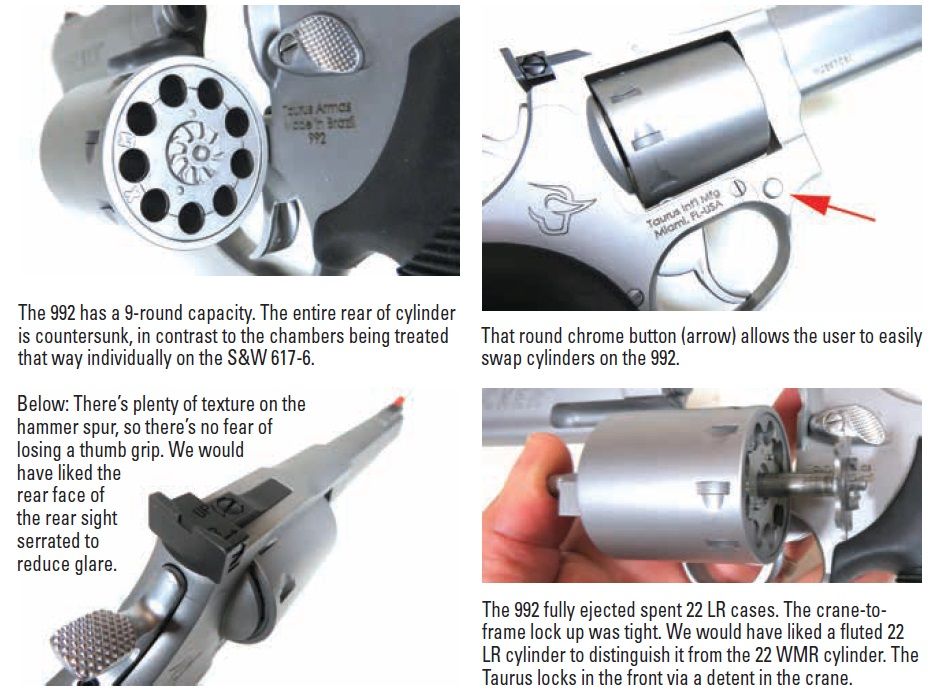
The trigger face is smooth and the hammer has a wide, checkered spur for sure cocking. The DA trigger pull is a hefty 15 pounds, and we could feel a bit of stacking. In SA mode, the weight was also a hefty 6.7 pounds, but it did break cleanly. This trigger came in third place to the fine S&W trigger, which came in first, and Ruger’s trigger, which came in second. The 992 incorporates the Taurus transfer-safety bar so the handgun can be carried fully loaded without fear of accidently discharge if dropped. Like the S&W, the Taurus also incorporates a hammer lock, which requires a key. We would use this feature when storing the gun.
The grip is compact and shorter than the Ruger and the S&W. It features Taurus’ ribbed rubber grip that flexes to accommodate the user’s hand size and grip. Our team liked these grips. Large-handed users may need to curl their small fingers under the butt.
At the range, we found the 992 offered the best accuracy of the three revolvers tested. With hot Aguila ammo, our best five-shot group at 15 yards measured 0.52 inches. With the mild PMC Target, our best measured 0.40 inches. On average, the 22 LR grouped under an inch.
Swapping cylinder assemblies was super simple, and with each, we noted the cylinders positively clicked into place with little play. We assumed the 22 WMR would not shoot to the 22 LR’s point of aim, and we were correct. It shot about an inch higher. Our best group with the 22 WMR was with the CCI 40-grain TMJ ammo, which measured 0.64 inches. On average, the 22 WMR ammo grouped from under an inch to 1.5 inches. We did not experience any splatter, and we swapped cylinders as easily as if they were magazines for a semi-automatic pistol. Even with fouling, the swap was easy to perform.
Our Team Said: For the price, the 992 offers a lot of versatility with the extra cylinder. We felt the DA and SA trigger pulls were too heavy. It is also awfully heavy for a kit gun, but for the price, we’ll disregard the heftiness. We think this is a Best Buy.
Ruger LCRx 5435 22 LR, $470
GUN TESTS GRADE: B+
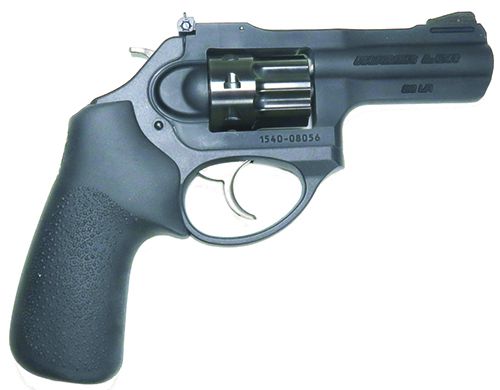
| Action | Revolver, Double Action |
| Overall Length | 7.5 in. |
| Barrel Length | 3.0 in. |
| Sight Radius | 4.2 in. |
| Overall Height | 5.5 in. |
| Maximum Width | 1.2 in. |
| Weight Unloaded | 17.3 oz. |
| Weight Loaded | 22.1 oz. |
| Cylinder Gap | 0.008 in. |
| Capacity | 8 |
| Frame Finish | Matte Black |
| Barrel/Cylinder Finish | Matte Black |
| Frame Front Strap Height | 2.2 in. |
| Frame Back Strap Height | 3.5 in. |
| Grip | Textured Rubber |
| Grip Thickness (max) | 1.2 in. |
| Grip Circumference (max) | 4.7 in. |
| Front Sight | Ramped, Pinned |
| Rear Sight | Adjustable U-notch |
| Trigger Pull Weight (DA) | 16.0 lbs. |
| Trigger Pull Weight (SA) | 6.3 lbs. |
| Trigger Span (DA) | 2.9 in. |
| Trigger Span (SA) | 2.5 in. |
| Safety | Transfer Bar |
| Warranty | None Written |
| Telephone | (928) 541-8892 |
| Website | Ruger.com |
| Made In | USA |
The LCRx has a distinct modern look to it. The LCRx is lighter and has less capacity than the other revolvers tested. On weight alone — 17.3 ounces unloaded — the LCRx would make a nice, modern interpretation of a kit gun. This revolver has an 8-round capacity and uses the LCR’s monolithic aluminum frame. The “x” designates an external hammer for SA mode. The LCR is a DAO revolver. It is a good thing the LCRx has SA mode because the DA trigger pull is a heavy 16 pounds. The friction-reducing trigger cam helps achieve a smooth, non-stacking trigger pull. The pull reminded some testers of a compound bow draw. The initial pull back on the bow and press on the LCRx trigger requires more pressure and effort. As you get to full draw with the compound bow or full press of the trigger, there is a reduction in pressure/effort. The trigger is not as smooth as the S&W trigger, but the cost to manufacture the LCRx trigger is significantly less, and that is reflected in the price of each revolver. In the past, we have tested 38 Special, 357 Magnum, and 9mm LCR variants and found the triggers to be just as smooth, but lighter.
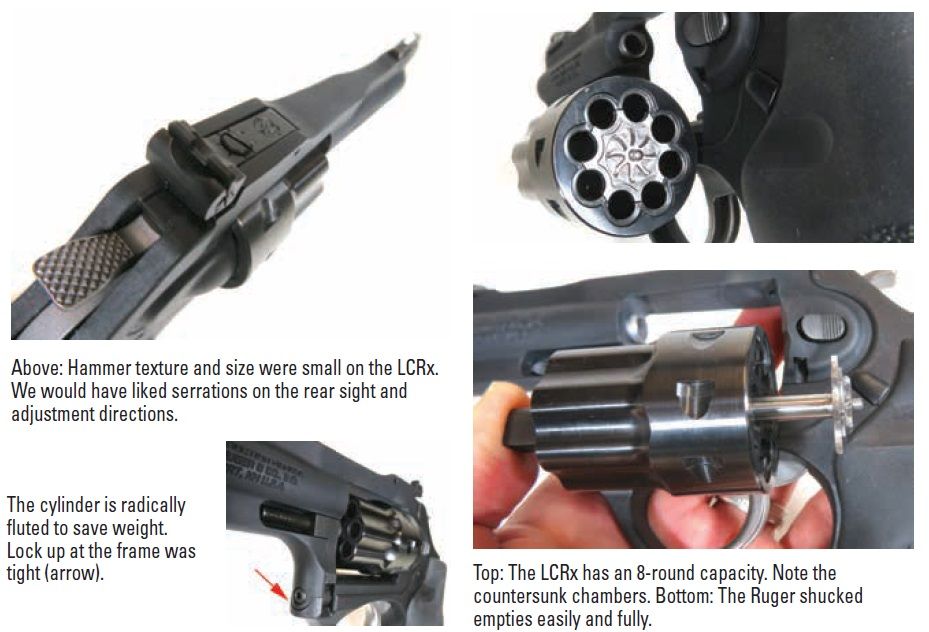
This revolver has an aluminum sleeve over a 3-inch steel barrel. The finish of the frame and barrel is matte black. The smooth trigger and hammer are stainless, and the radically fluted cylinder is blued. The chambers are countersunk. The hammer spur is wide and checkered enough for a sure grip when thumbing back the hammer. The firing mechanism uses Ruger’s safety transfer-bar system, so you can safely carry the LCRx fully loaded.
The grip is a Hogue Tamer Monogrip with a pebbled texture, slight palm swell, and length that allows a solid grip. Large-handed users may need to curl the little finger under the flat butt. We liked the grip because it allowed us a higher grip on the revolver, which helps control recoil. Not that a 22 LR provides a lot of recoil, but it also helps control when shooting in DA mode.
The front ramp sight is pinned in place and has a white insert, so it is easier to pick up on a dark-colored target. The rear sight is fully adjustable, but get out the manual to determine which direction to turn the screw. Ruger does not label the directions. For those of you who hate manuals, clockwise is down on the elevation screw and clockwise is left on the windage screw.
We found these sights wide enough to be easily acquired. The white ramp also helps sight alignment. Would we keep these sights if we owned this gun? Probably not, and that’s the convenient thing about pinned front sights. They can easily be changed out for an aftermarket sight like one from HiViz or XS Sights. Same goes for the S&W and Taurus.
Once we started shooting it, we found the LCRx had a definite like and dislike for some ammo. The smallest five-shot group was with the PMC target ammo, which measured 0.86 inches. The best we could shoot with the Winchester and Aguila cartridges was 0.92 and 1.49 inches, respectively. On average, groups measured 1.3 to 1.6 inches. Remember, all accuracy testing was done in SA mode. Moving to DA mode separated the shooters from the hacks, and unfortunately, most of us ended up in the hack category. The trigger pull on the LCRx is exceptionally smooth, as mentioned, but due to the revolver’s light weight and heavy trigger-pull, shooting tight groups in DA mode is not easy. Dare we say not possible. At spitting distance, use DA mode and at anything farther away use SA mode.
The ejector rod pushes cases all the way out. A pin in the underlug snaps in place when the cylinder is closed, locking up the front of the cylinder, similar to the S&W. We had no issues with the LCRx’s performance except for the DA trigger pull.
Our Team Said: What the LCRx offers is light weight, high grip hold, and reliability. Accuracy was acceptable, and that has a lot to do with the trigger. The DA trigger pull is not this revolver’s strong point. Thank goodness it has a SA mode. It would make good a kit gun if you can live with heavy DA trigger pull, but for the price, we might just pass on this revolver.
Special thanks to Eastern Outfitters (EasternOutfitter.com) of Hampstead, NC, for their assistance.
Written and photographed by Robert Sadowski, using evaluations from Gun Tests team testers.




























Hi Todd,
Comparing the Ruger LCR to a S&W 617 and a Taurus Tracker is pretty much comparing apples and oranges. The Ruger SP101 is very comparable to the other steel frame revolvers. and would have made for a very interesting comparison.
There are 3-key questions that need to be answered when we talk about 22 revolvers:
1) Trigger weight? Ruger uses a half moon shaped firing pin that requires more force than the older chisel type firing pins on S&W K22- and necessarily requires more force than the older types. What do the firing pins on the S&W 617 and Taurus Tracker look like?
2) How badly does each revolver spit? If you put a sheet of paper next to the barrel cylinder gap- during firing, do lead shavings penetrate the paper. Excessive spitting is a frequent occurrence and requires correction by the factory.
3) Does the cylinder tend to bind during firing? This is by definition an unsafe condition.
1950s era S&W 22 revolvers that I have handled and shot don’t seem to have those problems, but current revolvers seem to have these problems fairly frequently.
John in Louisiana
I don’t see the price on the Taurus….
Taurus 992 Tracker 2-992049 22 LR/22 WMR,
$489
GUN TESTS GRADE: A (BEST BUY)
$ 489. Just above the photo of the revolver.
Hey folks…. The S&W 617 is a “K” frame, not an “L” frame. It fits many K frame holsters, especially those made of softer stretchier leathers. K frame holsters made from harder materials may not work as they are generally molded to fit a model 10/13 heavy barrel profile and the underlug on the 617 binds it up pretty badly. There would be quite a bit of slop if you stuck it in a precisely molded L frame holster but it would work.
who writes this stuff.? 617 means it is stainless NOT that it is the 6th iteration of the model duh
Hey Millard Fillmore – better read up on S&W Revolvers there guy. While 617 is indeed a model number…the – (dash) indicates the “change” or iteration of that particular model.
Lovingly…duh!
M. Isham “EOD Marine”
Who proof reads your stats??
Very unacceptable.